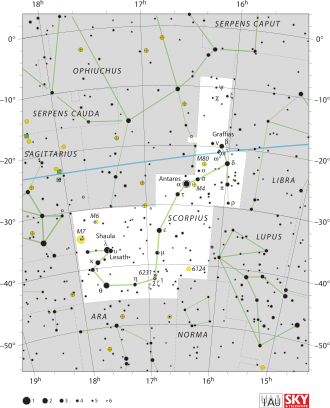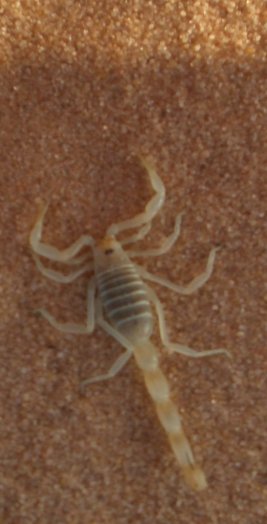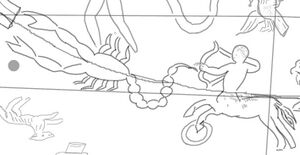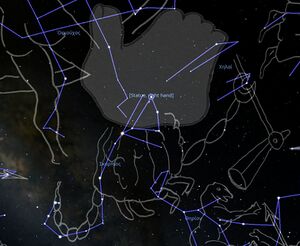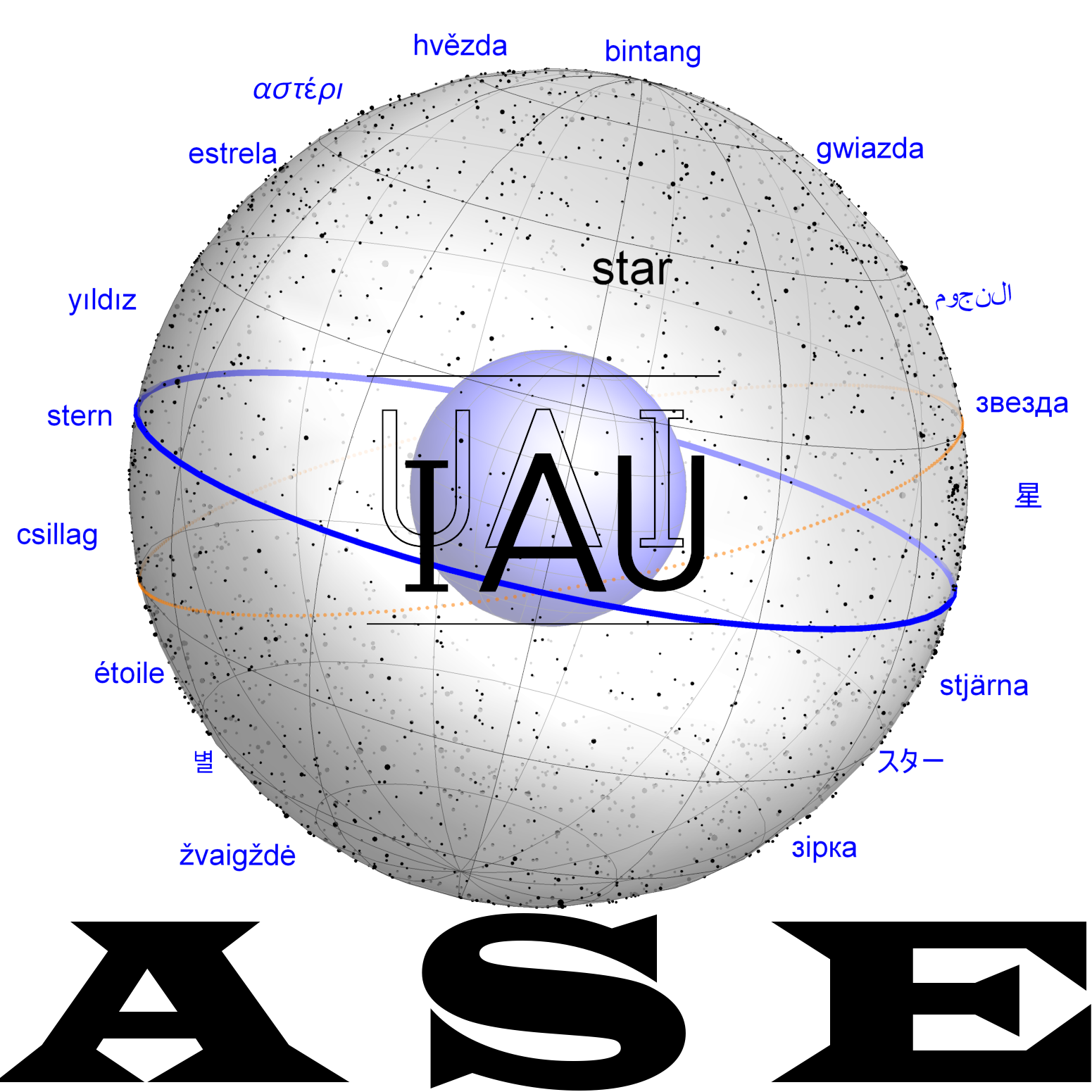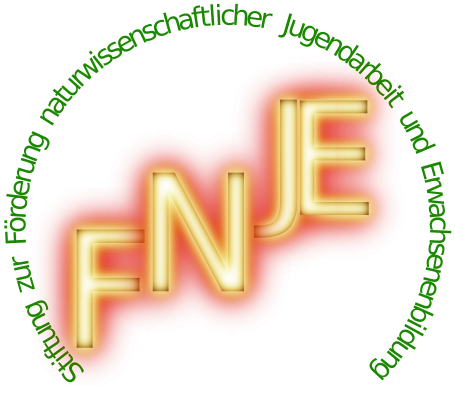Scorpius: Difference between revisions
(Created page with "alt=star chart|thumb|Sco star chart (IAU and Sky & Telescope magazine, Roger Sinnott & Rick Fienberg). One of the 88 IAU constellations. ==Etymology and History== The Greek constellation ... ===Origin of Constellation=== ===Transfer and Transformation of the Constellation=== ==Mythology== ==Weblinks== * ==References== *References (general) *References (Babylonian) *References (Greco-Roman...") Tags: Visual edit Disambiguation links |
No edit summary |
||
| (19 intermediate revisions by 2 users not shown) | |||
| Line 1: | Line 1: | ||
[[File:Scorpius IAU.svg|alt=star chart|thumb|Sco star chart (IAU and Sky & Telescope magazine, Roger Sinnott & Rick Fienberg).]] |
[[File:Scorpius IAU.svg|alt=star chart|thumb|Sco star chart (IAU and Sky & Telescope magazine, Roger Sinnott & Rick Fienberg).]] |
||
[[File:Skopion xs.jpg|thumb|a scorpion in the Sahara desert (2007).]] |
|||
One of the [[:Category:88_IAU-Constellations|88 IAU constellations]]. |
|||
One of the [[:Category:88_IAU-Constellations|88 IAU constellations]]. In contemporary history it was adopted from Ptolemy's Almagest (c. 137 CE) but this classical constellation has Babylonian roots (cf. [[GIR2.TAB|GÍR.TAB]]) The Italian form "Scorpio" is frequently used in astrology-pop culture but the Latin form "Scorpius" (a Greek loanword) is the name of both constellation and zodiac sign. |
|||
==Etymology and History== |
==Etymology and History== |
||
===Origin of Constellation=== |
|||
The Greek constellation ... |
|||
The scorpion came to Greece with the zodiac from Mesopotamia. In the Mesopotamian Epic of Gilgamesh, parts of which can be traced back to the 3rd millennium, scorpion men guard the entrance and exit of the sun. Scorpions or scorpion people are important in the sun cult. |
|||
==== Brightest Star ==== |
|||
The reddish star in the heart of Scorpius had a proper name in Mesopotamia, but this was not passed down. It was called Lisi ([[LI9.SI4|LI<sub>4</sub>.SI<sub>9</sub>]]), a deity regarded as the mother goddess's child and understood in early sources as a daughter, later as a son. The Greek name [[Antares]] (anti-ares, counterpart or rival of Mars) is only documented in Roman times; it is one of the few star names in the Almagest. |
|||
Horowitz ( ) suggested that the Greek name "anti ares" roots in a misunderstanding or pun from the Babylonian term [[AN.TA.GUB]], as GUB can also be read RE<sub>6</sub>. |
|||
===Origin of Constellation=== |
|||
==== Babylonian ==== |
|||
[[File:Kugel Sgr+CrA+Sco.JPG|thumb|Kugel Globe: Sco and Sgr with CrA.]] |
|||
==== Greco-Roman ==== |
|||
===== Aratos ===== |
|||
<blockquote>Now the point o f the Serpent’s jaw lies close to the Crown, but under its coil you can look for the great Claws, [90] though these are lack-lustre and not at all brilliant. (Kidd 1997)</blockquote> |
|||
===== Eratosthenes ===== |
|||
<blockquote>'''Var. 1:''' Given its large size, it can be divided into two dodecatamories. The pincers occupy one sign, and the body and stinger another. Artemis, it is said, made it rise from the summit of the island of Chios so that it could sting Orion and the latter would die, because Orion, in defiance of everything, had tried to rape the goddess during a hunt. Zeus placed Scorpius among the brilliant constellations, so that men of later generations would know its power and its effects. Scorpius has two stars on each claw - those in front are large, those behind are dim - three on the forehead - one of which is bright, the middle one - three bright stars on the back, two on the belly, five on the tail and two on the sting. These stars are led by the most beautiful of all, the bright star on the northern pincer. In all, nineteen.</blockquote><blockquote>'''Var. 2:''' Given its large size, it can be divided into two dodecatamories. The claws occupy one sign, and the body and stinger another. Orion is thought to have been killed by Gè, because he had proclaimed before Artemis that no beast would escape him; this sign appears as a symbol of the event. It is said that he stung Orion and that Orion died. Zeus placed Scorpius among the constellations because it was an extraordinary work of Gè, so that future generations would know its stature and power. know its stature and power. Scorpius has two stars on each of its claws - those in front are large and the other two are dim - and three on its forehead. three on the forehead - one of which is bright, the middle one three bright stars on the back, two on the belly, five on the tail, and two shiny ones on the sting. In all, there were nineteen. (Pamias and Zucker 2013)</blockquote> |
|||
===== Hipparchus ===== |
|||
===== Hyginus, Astronomica ===== |
|||
<blockquote>This sign is divided into two parts on account of the great spread of the claws. One part of it our writers have called the Balance. |
|||
But the whole of the constellation was put in the sky, it is said, for the following reason: Orion since he used to hunt, and felt confident that he was most skilled of all in that pursuit, said even to Diana and Latona that he was able to kill anything the produced. Earth, angered at this, sent the scorpion which is said to have killed him. Jove, however, admiring the courage of both, put the scorpion among the stars, as a lesson to men not to be too self-confident. Diana, then, because of her affection for Orion, asked Jove to show to her request the same favour he had given of his own accord to Earth. And so the constellation was established in such a way that when Scorpion rises, Orion sets. (Mary Ward 1960)</blockquote> |
|||
===== Geminos ===== |
|||
[[File:Sco Farnese stellarium.jpg|thumb|Scorpius as drawn on the Farnese Globe, holding the Balance in its Claws and partially covered by the hand of Atlas. The stick figures outline the constellations as described in the Almagest in comparison (drawings and mapping by SMH 2021, Stellarium)]] |
|||
==== Almagest Σκορπίος ==== |
|||
{| class="wikitable" |
|||
!id |
|||
!Greek |
|||
(Heiberg 1898) |
|||
!English |
|||
(Toomer 1984) |
|||
!ident. |
|||
|- |
|||
! |
|||
!Σκορπίου ἀστερισμός |
|||
!Constellation of Scorpius |
|||
! |
|||
|- |
|||
| 1 |
|||
|τῶν ἐν τῷ μετώπῳ λαμπρῶν φ’ ὁ βόρειος |
|||
|The northernmost of the 3 bright stars in the forehead |
|||
|bet Sco |
|||
|- |
|||
|2 |
|||
|ὁ μέσος αὐτῶν |
|||
|The middle one of these |
|||
|del Sco |
|||
|- |
|||
| 3 |
|||
|ὁ νοτιώτερος τῶν τριῶν |
|||
|The southernmost of the three |
|||
|pi Sco |
|||
|- |
|||
| 4 |
|||
|ὁ τούτου ἔτι νοτιώτερος ἐφ’ ἑνὸς τῶν ποδῶν |
|||
|The star south again of this, on one of the legs |
|||
|rho Sco |
|||
|- |
|||
|5 |
|||
|τῶν β τῶν παρακειμένων τῷ βορειοτάτῳ τῶν λαμπρῶν ὁ βόρειος |
|||
|The northernmost of the 2 stars adjacent to the northernmost of the bright ones |
|||
|nu Sco |
|||
|- |
|||
|6 |
|||
|ὁ φότιος αὐτῶν |
|||
|The southernmost of these |
|||
|ome1 + ome2 Sco |
|||
|- |
|||
|7 |
|||
|τῶν ἐν τῷ σώματι φ’ λαμπρῶν ὁ προηγούμευος. |
|||
|The most advanced of the 3 bright stars in the body |
|||
|sig Sco |
|||
|- |
|||
|8 |
|||
|ὁ μέσος αὐτῶν καὶ ὑπόκιρρος καλούμενος Ἀντάρης. |
|||
|The middle one of these, which is reddish and called 'Antares' |
|||
|alf Sco |
|||
|- |
|||
|9 |
|||
|ὁ ἑπόμενος τῶν γ. |
|||
|The rearmost of the 3 |
|||
|tau Sco |
|||
|- |
|||
|10 |
|||
|τῶν ὑπ’ αὐτοὺς β ὡς ἐπὶ τοῦ ἐσχάτου ποδὸς ὁ ἠγούμενος. |
|||
|The advance star of the 2 under these, approximately on the last leg |
|||
|13 Sco |
|||
|- |
|||
|11 |
|||
|ὁ ἐπόμενος αὐτῶν. |
|||
|The rearmost of these |
|||
|HR 6070 |
|||
|- |
|||
|12 |
|||
|ὁ ἐν τῷ α’ ἀπὸ τοῦ σώματος σπουδύλῳ |
|||
|The star in the first [tail-J joint from the body |
|||
|eps Sco |
|||
|- |
|||
|13 |
|||
|ὁ μετὰ τοῦτον ἐν τῷ β’ σπονδύλῳ |
|||
|The one after this, in the 2nd joint |
|||
|mu1 + mu2 Sco |
|||
|- |
|||
|14 |
|||
|τοῦ ἐν τῷ γ’ σπονδύλῳ διπλοῦ ὁ βόρειος. |
|||
|The northern star of the double-star in the 3rd joint |
|||
|zet2 Sco |
|||
|- |
|||
|15 |
|||
|ὁ νοτιώτερος τοῦ διπλοῦ |
|||
|The southern star of the double-star |
|||
|zet1 Sco |
|||
|- |
|||
|16 |
|||
|ὁ ἐφεξῆς ἐν τῷ δ’ σπουδύλῳ |
|||
|The one following, in the 4th joint |
|||
|eta Sco |
|||
|- |
|||
|17 |
|||
|ὁ ἐφεξῆς ἐν τῷ δ’ σπουδύλῳ |
|||
|The one after that, in the Sth joint |
|||
|tet Sco |
|||
|- |
|||
|18 |
|||
|ὁ ἔτι ἐφεξῆς ἐν τῷ ς’ σπουδύλῳ |
|||
|The next one again, in the 6th joint |
|||
|iot1 Sco |
|||
|- |
|||
|19 |
|||
|ὁ ἐν τῷ ξ’ σπουδύλῳ τῷ παρὰ τὸ κέντρου. |
|||
|The star in the 7th joint, the joint next to the sting |
|||
|kap Sco |
|||
|- |
|||
|20 |
|||
|τῶν ἐν τῷ κέντρῳ β’ ὁ ἑπόμενος. |
|||
|The rearmost of the 2 stars in the sting |
|||
|lam Sco |
|||
|- |
|||
|21 |
|||
|ὁ ἠγούμενος αὐτῶν |
|||
|The more advanced of these |
|||
|ups Sco |
|||
|- |
|||
| |
|||
| |
|||
| |
|||
| |
|||
|- |
|||
| |
|||
|ἀστέρες κα, ὥυ β’ μεγέθους α, γ’ φ, δ’ ε, ε β |
|||
|21 stars, I of the second magnitude, 13 of the third, S of the fourth, 2 of the ftfth |
|||
| |
|||
|- |
|||
| |
|||
| |
|||
| |
|||
| |
|||
|- |
|||
! |
|||
!Οἱ περὶ τὸν Σκορπίου ἀμόρφωτοι |
|||
!Stars araund Scorpius outside the constellation |
|||
! |
|||
|- |
|||
|22 |
|||
|ὁ ἐπόμενος τῷ κέντρῳ νεφελοειδήρ |
|||
|The nebulous star to the rear of the sting |
|||
|G Sco |
|||
|- |
|||
|23 |
|||
|τῶν ἀπ’ ἄρκτων τοῦ κέντρου β ὁ προηγούμενος. |
|||
|The most advanced of the 2 stars to the north of the sting |
|||
|45 Oph |
|||
|- |
|||
|24 |
|||
|ὁ ἑπόμευος αὐτῶν. |
|||
|The rearmost of them |
|||
|3 Sgr |
|||
|- |
|||
| |
|||
| |
|||
| |
|||
| |
|||
|- |
|||
| |
|||
|ἀστέρες 7, ὥν ε μεγέθους β, νεφελοειδὴς ἂ. |
|||
|{3 stars, 2 of the fifth magnitude, I nebulous} |
|||
| |
|||
|} |
|||
===Transfer and Transformation of the Constellation=== |
===Transfer and Transformation of the Constellation=== |
||
As Scorpius are also widespread in the Mediterranean region and the constellation is characterised by relatively clear outlines, hardly any changes have occurred over the millennia - with the exception of the occasional reinterpretation of its northern parts ([[Libra]]). |
|||
==== Scorpius in the Zodiac ==== |
|||
The southern part of the constellation, i.e. the tail and sting of the scorpion, extend very far southwards from the ecliptic. Essentially, only the scissors and the head lie in the zodiac. Because the Babylonian constellation Libra was reinserted into the zodiac in Roman times, stars from Scorpius were used for it. The problem was that the recumbent Greek Virgo was wider than the upright Babylonian goddess. This meant that there was no more room for Libra next to the Greek Virgo. Since the scissors were split off and renamed "Libra" in modern time, the scorpion today only covers about 5° of the ecliptic, although the zodiac signs are supposed to be 30° long. The sun is, therefore, not in this constellation for a month, but only for about 5 days (24 to 29 November). The rest of the zodiac sign (section of the ecliptic) is covered by the constellation [[Ophiuchus]].<gallery> |
|||
File:Kugel Sgr+CrA+Sco.JPG|Scorpius as drawn on the Kugel Globe (1st c. BCE, drawing by SMH 2024) |
|||
File:Sco mainz.jpg|Scorpius on the Mainz Globe (2nd c. CE), drawing by SMH 2021 |
|||
File:Sco Farnese stellarium.jpg|Scorpius as drawn on the Farnse Globe, holding the Balance in its Claws and partially covered by the hand of Atlas. The stick figures outline the constellations as described in the Almagest in comparison (drawings and mapping by SMH 2021, Stellarium) |
|||
File:Aratea 10v.jpg|Scorpius with Ophiuchus in the Leiden Aratea (c.830 CE) |
|||
File:Scorpio et Libra - Mercator.jpeg|Scorpius in Mercator Globe (1551) |
|||
File:Uranometria Scorpius.png|Scorpius in Bayer's Uranometria (1603) |
|||
File:Scorpius Hevelius.jpg|Scorpius in Hevelius (1690) |
|||
File:Johann Elert Bode - Scorpio & Libra.jpg|Scorpius in Bode (1782/1805) |
|||
File:XV. Sagittarius, Scorpius, Corona Australis, Ara, Lupus, Tubus, Norma Regula, Astronomicus.jpg|Scorpius and Sagittarius in Bode's Uranographia (1801) |
|||
File:1822 - Alexander Jamieson - Scorpio and Libra.jpg|Scorpius in Jamieson (1822) |
|||
</gallery> |
|||
==Mythology== |
==Mythology== |
||
For Eratosthenes, the scorpion is part of the mythological complex surrounding Orion. In the chapter on the scorpion, he reports the same legend as Aratos: Artemis had the scorpion emerge from a hill to prevent the impetuous Orion from getting too close to her. Artemis and Orion were hunting together on the island of Chios when he was struck by the scorpion's sting and mortally wounded. |
|||
In the chapter for Orion himself, however, it is said that Mother Earth sent the scorpion to punish Orion's arrogance and poaching. |
|||
In Mesopotamia, this male figure is certainly one of the oldest constellations. It is connected to the oldest myth that we can currently reconstruct: the Gilgamesh epic. In its prehistory, a deluge is reported. Flood stories have been handed down in several cultures. The Babylonian story is very similar in some topoi to the biblical story of Noah. This is no coincidence, as a transfer through the exile of the Jewish elite under the Babylonian king Nebuchadnezzar is documented and attested in the Bible: the Greek and Jewish Flood stories can therefore certainly be traced back to the Sumerian story. |
|||
Our hero only appears much later: Gilgamesh, King of Uruk. He loses his friend and comrade Enkidu after they have freed Uruk together from the beast called the Heavenly Bull ([[Taurus]]). Gilgamesh then goes in search of eternal life, which is not normally granted to humans. He learns that his ancestor Utnapishtim (the Babylonian Noah) was, however, exceptionally granted eternal life by the gods because he had saved humanity from the Flood. Gilgamesh therefore sets off in search of Utnapishtim to ask him about this. Along the way, he comes to Mount Mashu, which he had to cross. The passage through the mountain took 12 double hours and the entrance to the mountain was guarded by a male and a female scorpion-being. They were horrible to look at, but Gilgamesh was brave enough to stop and talk to them. Then they let him pass. |
|||
After a few more paths, Gilgamesh finds Utnapishtim and the realisation that eternal life is not achieved through a magic herb or gods, but only through one's own deeds, with which one remains in people's memories - preferably in a positive way. |
|||
==Weblinks== |
==Weblinks== |
||
| Line 30: | Line 242: | ||
[[Category:Modern]] |
[[Category:Modern]] |
||
[[Category:88 IAU-Constellations]] |
[[Category:88 IAU-Constellations]] |
||
[[Category:European]] |
[[Category:European]][[Category:Zodiac]] |
||
[[Category:4work]] |
[[Category:4work]] |
||
Latest revision as of 13:26, 5 September 2025
One of the 88 IAU constellations. In contemporary history it was adopted from Ptolemy's Almagest (c. 137 CE) but this classical constellation has Babylonian roots (cf. GÍR.TAB) The Italian form "Scorpio" is frequently used in astrology-pop culture but the Latin form "Scorpius" (a Greek loanword) is the name of both constellation and zodiac sign.
Etymology and History
Origin of Constellation
The scorpion came to Greece with the zodiac from Mesopotamia. In the Mesopotamian Epic of Gilgamesh, parts of which can be traced back to the 3rd millennium, scorpion men guard the entrance and exit of the sun. Scorpions or scorpion people are important in the sun cult.
Brightest Star
The reddish star in the heart of Scorpius had a proper name in Mesopotamia, but this was not passed down. It was called Lisi (LI4.SI9), a deity regarded as the mother goddess's child and understood in early sources as a daughter, later as a son. The Greek name Antares (anti-ares, counterpart or rival of Mars) is only documented in Roman times; it is one of the few star names in the Almagest.
Horowitz ( ) suggested that the Greek name "anti ares" roots in a misunderstanding or pun from the Babylonian term mulAN.TA.GUB, as GUB can also be read RE6.
Babylonian
Greco-Roman
Aratos
Now the point o f the Serpent’s jaw lies close to the Crown, but under its coil you can look for the great Claws, [90] though these are lack-lustre and not at all brilliant. (Kidd 1997)
Eratosthenes
Var. 1: Given its large size, it can be divided into two dodecatamories. The pincers occupy one sign, and the body and stinger another. Artemis, it is said, made it rise from the summit of the island of Chios so that it could sting Orion and the latter would die, because Orion, in defiance of everything, had tried to rape the goddess during a hunt. Zeus placed Scorpius among the brilliant constellations, so that men of later generations would know its power and its effects. Scorpius has two stars on each claw - those in front are large, those behind are dim - three on the forehead - one of which is bright, the middle one - three bright stars on the back, two on the belly, five on the tail and two on the sting. These stars are led by the most beautiful of all, the bright star on the northern pincer. In all, nineteen.
Var. 2: Given its large size, it can be divided into two dodecatamories. The claws occupy one sign, and the body and stinger another. Orion is thought to have been killed by Gè, because he had proclaimed before Artemis that no beast would escape him; this sign appears as a symbol of the event. It is said that he stung Orion and that Orion died. Zeus placed Scorpius among the constellations because it was an extraordinary work of Gè, so that future generations would know its stature and power. know its stature and power. Scorpius has two stars on each of its claws - those in front are large and the other two are dim - and three on its forehead. three on the forehead - one of which is bright, the middle one three bright stars on the back, two on the belly, five on the tail, and two shiny ones on the sting. In all, there were nineteen. (Pamias and Zucker 2013)
Hipparchus
Hyginus, Astronomica
This sign is divided into two parts on account of the great spread of the claws. One part of it our writers have called the Balance. But the whole of the constellation was put in the sky, it is said, for the following reason: Orion since he used to hunt, and felt confident that he was most skilled of all in that pursuit, said even to Diana and Latona that he was able to kill anything the produced. Earth, angered at this, sent the scorpion which is said to have killed him. Jove, however, admiring the courage of both, put the scorpion among the stars, as a lesson to men not to be too self-confident. Diana, then, because of her affection for Orion, asked Jove to show to her request the same favour he had given of his own accord to Earth. And so the constellation was established in such a way that when Scorpion rises, Orion sets. (Mary Ward 1960)
Geminos
Almagest Σκορπίος
| id | Greek
(Heiberg 1898) |
English
(Toomer 1984) |
ident. |
|---|---|---|---|
| Σκορπίου ἀστερισμός | Constellation of Scorpius | ||
| 1 | τῶν ἐν τῷ μετώπῳ λαμπρῶν φ’ ὁ βόρειος | The northernmost of the 3 bright stars in the forehead | bet Sco |
| 2 | ὁ μέσος αὐτῶν | The middle one of these | del Sco |
| 3 | ὁ νοτιώτερος τῶν τριῶν | The southernmost of the three | pi Sco |
| 4 | ὁ τούτου ἔτι νοτιώτερος ἐφ’ ἑνὸς τῶν ποδῶν | The star south again of this, on one of the legs | rho Sco |
| 5 | τῶν β τῶν παρακειμένων τῷ βορειοτάτῳ τῶν λαμπρῶν ὁ βόρειος | The northernmost of the 2 stars adjacent to the northernmost of the bright ones | nu Sco |
| 6 | ὁ φότιος αὐτῶν | The southernmost of these | ome1 + ome2 Sco |
| 7 | τῶν ἐν τῷ σώματι φ’ λαμπρῶν ὁ προηγούμευος. | The most advanced of the 3 bright stars in the body | sig Sco |
| 8 | ὁ μέσος αὐτῶν καὶ ὑπόκιρρος καλούμενος Ἀντάρης. | The middle one of these, which is reddish and called 'Antares' | alf Sco |
| 9 | ὁ ἑπόμενος τῶν γ. | The rearmost of the 3 | tau Sco |
| 10 | τῶν ὑπ’ αὐτοὺς β ὡς ἐπὶ τοῦ ἐσχάτου ποδὸς ὁ ἠγούμενος. | The advance star of the 2 under these, approximately on the last leg | 13 Sco |
| 11 | ὁ ἐπόμενος αὐτῶν. | The rearmost of these | HR 6070 |
| 12 | ὁ ἐν τῷ α’ ἀπὸ τοῦ σώματος σπουδύλῳ | The star in the first [tail-J joint from the body | eps Sco |
| 13 | ὁ μετὰ τοῦτον ἐν τῷ β’ σπονδύλῳ | The one after this, in the 2nd joint | mu1 + mu2 Sco |
| 14 | τοῦ ἐν τῷ γ’ σπονδύλῳ διπλοῦ ὁ βόρειος. | The northern star of the double-star in the 3rd joint | zet2 Sco |
| 15 | ὁ νοτιώτερος τοῦ διπλοῦ | The southern star of the double-star | zet1 Sco |
| 16 | ὁ ἐφεξῆς ἐν τῷ δ’ σπουδύλῳ | The one following, in the 4th joint | eta Sco |
| 17 | ὁ ἐφεξῆς ἐν τῷ δ’ σπουδύλῳ | The one after that, in the Sth joint | tet Sco |
| 18 | ὁ ἔτι ἐφεξῆς ἐν τῷ ς’ σπουδύλῳ | The next one again, in the 6th joint | iot1 Sco |
| 19 | ὁ ἐν τῷ ξ’ σπουδύλῳ τῷ παρὰ τὸ κέντρου. | The star in the 7th joint, the joint next to the sting | kap Sco |
| 20 | τῶν ἐν τῷ κέντρῳ β’ ὁ ἑπόμενος. | The rearmost of the 2 stars in the sting | lam Sco |
| 21 | ὁ ἠγούμενος αὐτῶν | The more advanced of these | ups Sco |
| ἀστέρες κα, ὥυ β’ μεγέθους α, γ’ φ, δ’ ε, ε β | 21 stars, I of the second magnitude, 13 of the third, S of the fourth, 2 of the ftfth | ||
| Οἱ περὶ τὸν Σκορπίου ἀμόρφωτοι | Stars araund Scorpius outside the constellation | ||
| 22 | ὁ ἐπόμενος τῷ κέντρῳ νεφελοειδήρ | The nebulous star to the rear of the sting | G Sco |
| 23 | τῶν ἀπ’ ἄρκτων τοῦ κέντρου β ὁ προηγούμενος. | The most advanced of the 2 stars to the north of the sting | 45 Oph |
| 24 | ὁ ἑπόμευος αὐτῶν. | The rearmost of them | 3 Sgr |
| ἀστέρες 7, ὥν ε μεγέθους β, νεφελοειδὴς ἂ. | {3 stars, 2 of the fifth magnitude, I nebulous} |
Transfer and Transformation of the Constellation
As Scorpius are also widespread in the Mediterranean region and the constellation is characterised by relatively clear outlines, hardly any changes have occurred over the millennia - with the exception of the occasional reinterpretation of its northern parts (Libra).
Scorpius in the Zodiac
The southern part of the constellation, i.e. the tail and sting of the scorpion, extend very far southwards from the ecliptic. Essentially, only the scissors and the head lie in the zodiac. Because the Babylonian constellation Libra was reinserted into the zodiac in Roman times, stars from Scorpius were used for it. The problem was that the recumbent Greek Virgo was wider than the upright Babylonian goddess. This meant that there was no more room for Libra next to the Greek Virgo. Since the scissors were split off and renamed "Libra" in modern time, the scorpion today only covers about 5° of the ecliptic, although the zodiac signs are supposed to be 30° long. The sun is, therefore, not in this constellation for a month, but only for about 5 days (24 to 29 November). The rest of the zodiac sign (section of the ecliptic) is covered by the constellation Ophiuchus.
Mythology
For Eratosthenes, the scorpion is part of the mythological complex surrounding Orion. In the chapter on the scorpion, he reports the same legend as Aratos: Artemis had the scorpion emerge from a hill to prevent the impetuous Orion from getting too close to her. Artemis and Orion were hunting together on the island of Chios when he was struck by the scorpion's sting and mortally wounded.
In the chapter for Orion himself, however, it is said that Mother Earth sent the scorpion to punish Orion's arrogance and poaching.
In Mesopotamia, this male figure is certainly one of the oldest constellations. It is connected to the oldest myth that we can currently reconstruct: the Gilgamesh epic. In its prehistory, a deluge is reported. Flood stories have been handed down in several cultures. The Babylonian story is very similar in some topoi to the biblical story of Noah. This is no coincidence, as a transfer through the exile of the Jewish elite under the Babylonian king Nebuchadnezzar is documented and attested in the Bible: the Greek and Jewish Flood stories can therefore certainly be traced back to the Sumerian story.
Our hero only appears much later: Gilgamesh, King of Uruk. He loses his friend and comrade Enkidu after they have freed Uruk together from the beast called the Heavenly Bull (Taurus). Gilgamesh then goes in search of eternal life, which is not normally granted to humans. He learns that his ancestor Utnapishtim (the Babylonian Noah) was, however, exceptionally granted eternal life by the gods because he had saved humanity from the Flood. Gilgamesh therefore sets off in search of Utnapishtim to ask him about this. Along the way, he comes to Mount Mashu, which he had to cross. The passage through the mountain took 12 double hours and the entrance to the mountain was guarded by a male and a female scorpion-being. They were horrible to look at, but Gilgamesh was brave enough to stop and talk to them. Then they let him pass.
After a few more paths, Gilgamesh finds Utnapishtim and the realisation that eternal life is not achieved through a magic herb or gods, but only through one's own deeds, with which one remains in people's memories - preferably in a positive way.
